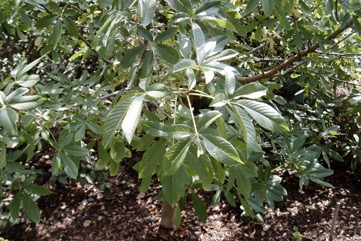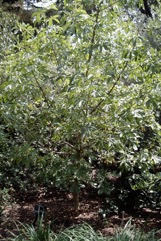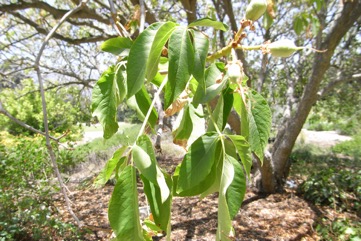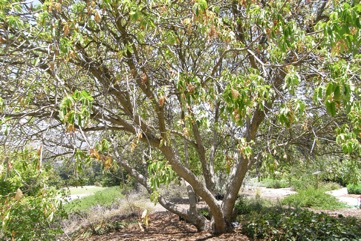Californian Buckeye, Californian Horse-Chestnut, Berraco

It is a temperate plant. It grows naturally near moist stream borders, scrub and the edges of oak and pine woods in canyons and dry slopes below 1200 metres in California. It requires a dry well drained sunny location. It does best in areas where the temperatures do not go below -10°C. It suits hardiness zones 7-10.
Synonyms
- Pavia californica (Spach.) Hartw.
Edible Portion
- Seeds, Caution
Where does Californian Buckeye grow?
Found in: Australia, Central America, Mexico, North America, United States
Notes: The seed contains about 23% protein on a fresh weight basis. There are 13 Aesculus species. Also put in the family Hippocastanaceae.
Growing Californian Buckeye, Californian Horse-Chestnut, Berraco
Cultivation: Plants can be grown from seed. The seed should be sown fresh but germinate quickly. Plants transplant easily. Stored seed should be soaked for 24 hours before sowing. It can be grown from root cuttings.
Edible Uses: Caution: This plant contains saponins which although poisonous are not normally easily absorbed by the body. It is nevertheless probably not wise to eat large quantities. The seeds are eaten cooked. Before eating they are slowly roasted then crushed and washed for 2-5 days in running water. They are then dried and ground into a powder.
Production: A moderately fast-growing and long-lived tree.
Nutrition Info
per 100g edible portion| Edible Part | Energy (kcal) | Protein (g) | Iron (mg) | Vitamin A (ug) | Vitamin c (mg) | Zinc (mg) | % Water |
|---|---|---|---|---|---|---|---|
| Seeds | - | - | - | - | - | - |
Californian Buckeye, Californian Horse-Chestnut, Berraco Photos




References
Beckstrom-Sternberg, Stephen M., and James A. Duke. "The Foodplant Database." http://probe.nalusda.gov:8300/cgi-bin/browse/foodplantdb.(ACEDB version 4.0 - data version July 1994)
Biocyclopedia Edible Plant Species. biocyclopedia.org
Bircher, A. G. & Bircher, W. H., 2000, Encyclopedia of Fruit Trees and Edible Flowering Plants in Egypt and the Subtropics. AUC Press. p 11
Bocek, B. R., 1984, Ethnobotany of Costanoan Indians, California, Based on Collections by John P. Harrington. Economic Botany 38(2): 240-255
Bodkin, F., 1991, Encyclopedia Botanica. Cornstalk publishing, p 54
Brickell, C. (Ed.), 1999, The Royal Horticultural Society A-Z Encyclopedia of Garden Plants. Convent Garden Books. p 84
Brouk, B., 1975, Plants Consumed by Man. Academic Press, London. p 214
Coombes, A.J., 2000, Trees. Dorling Kindersley Handbooks. p 178
Cundall, P., (ed.), 2004, Gardening Australia: flora: the gardener's bible. ABC Books. p 106
Etherington, K., & Imwold, D., (Eds), 2001, Botanica's Trees & Shrubs. The illustrated A-Z of over 8500 trees and shrubs. Random House, Australia. p 76
Hedrick, U.P., 1919, (Ed.), Sturtevant's edible plants of the world. p 27
Heywood, V.H., Brummitt, R.K., Culham, A., and Seberg, O. 2007, Flowering Plant Families of the World. Royal Botanical Gardens, Kew. p 292 (Family)
Menninger, E.A., 1977, Edible Nuts of the World. Horticultural Books. Florida p 113
Plants for a Future database, The Field, Penpol, Lostwithiel, Cornwall, PL22 0NG, UK. http://www.scs.leeds.ac.uk/pfaf/
Ryan, S., 2008, Dicksonia. Rare Plants Manual. Hyland House. p 5
Saunders, C.F., 1948, Edible and Useful Wild Plants. Dover. New York. p 81
J. Torrey & A. Gray, Fl. N. Amer. 1:251. 1838
Wickens, G.E., 1995, Edible Nuts. FAO Non-wood forest products. FAO, Rome. p 132